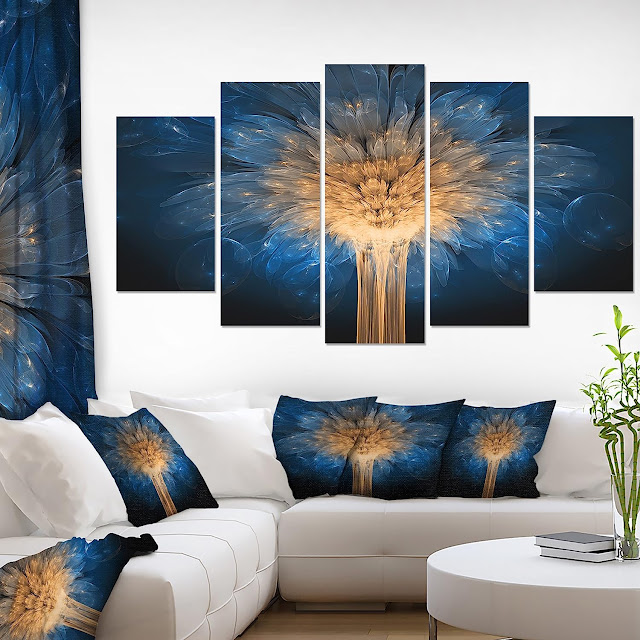Unleashing Creativity in a Three-Dimensional World: 3D Canvas
Introduction : The range of artistic expression has increased beyond conventional mediums in the current digital era. The development of 3D canvas has completely changed how both artists and consumers perceive art. With its capacity to enhance artwork's depth, texture, and realism, the 3D canvas has developed into an enthralling platform for imaginative minds to let their hair down. We will go into the realm of 3D canvas in this essay, looking at its advantages, uses, and potential future for both artists and aficionados.
3D Blue Dragon Flower-Abstract Art Canvas
1. The Evolution of Canvas: From 2D to 3D
Artistic expression has long relied on the canvas as a foundational medium. Canvas has typically been a two-dimensional surface on which painters have painted their greatest works. But as technology advanced, artists tried to expand the possibilities of the conventional canvas and add a third dimension. The advent of 3D canvas brought about a profound change in the field of art by enabling a more dynamic and immersive experience for both makers and viewers.
2. Understanding the 3D Canvas
A 3D canvas refers to a physical or digital medium that offers a three-dimensional space for artists to work on. The 3D canvas, in contrast to its 2D predecessor, gives the artwork dimension, volume, and texture, improving its appeal and realism. It is now possible for artists to edit and mold their works in previously unthinkable ways, creating a genuinely multidimensional art form.
5 Pcs Canvas Wall Art 3D Printed Picture Poster Artwork for Living Room Bedroom Office Home Decoration3. Tools and Techniques for Creating 3D Art
Creating art on a 3D canvas requires specialized tools and techniques. Sculpting materials like clay, wire, or foam are commonly used for physical 3D art, allowing artists to mold and shape their creations. These software applications enable artists to bring their ideas to life, manipulating virtual objects with precision and detail.
4. The Versatility of 3D Canvas in Different Art Forms
The versatility of 3D canvas transcends various art forms. Sculptors can use physical materials to carve intricate statues, breathing life into their subjects. Digital artists can create virtual worlds, characters, and animations that transport viewers into immersive experiences. Architects can utilize 3D canvas to visualize and present their designs with unparalleled accuracy. The possibilities are endless, as 3D canvas seamlessly integrates with painting, sculpture, animation, gaming, architecture, and more.
5. Exploring the Applications of 3D Canvas
The applications of 3D canvas are vast and wide-ranging. In the entertainment industry, 3D canvas has revolutionized the creation of visual effects in movies and video games, allowing for realistic simulations and captivating storytelling. In the field of medicine, 3D canvas assists in the visualization of complex anatomical structures, aiding in surgical planning and education. Additionally, 3D canvas finds applications in product design, virtual reality experiences, and even scientific research.
6. Bridging the Gap Between Traditional and Digital Art
As a link between conventional and digital art, 3D canvas gives creators the chance to merge the best of both worlds.. Traditional artists can leverage 3D canvas to add depth and dimension to their paintings or sculptures, breathing new life into their creations. Digital artists, on the other hand, can incorporate traditional art techniques into their virtual designs, infusing a sense of realism and organic aesthetics. This fusion of traditional and digital art opens up endless possibilities for creativity and expression.
7. Advancements & Innovations for 3D Canvas in the Future
The future of 3D canvas is bright as technology develops. Innovations like virtual reality integration and haptic feedback technologies are pushing the boundaries of 3D art. The goal of these developments is to converge the physical and digital worlds and improve the sensory experience for both creators and spectators. Artists will also be able to quickly translate their digital works into the actual world as 3D printing technology becomes more widely available, significantly broadening the possibilities of the 3D canvas.
Conclusion
New avenues for artistic expression have opened up with the introduction of 3D canvas. The 3D canvas has transformed how artists produce and viewers perceive art thanks to its capacity to bring depth, texture, and realism to works of art. With 3D canvas, there are countless creative and innovative possibilities in the fields of building, sculpture, animation, and painting. We can only anticipate new innovations and fascinating advancements in the field of 3D art as technology continues to advance.
FAQs
Q1: Can anyone create art on a 3D canvas?
Ans:Absolutely! Anyone interested in developing their creativity can use a 3D canvas. The 3D canvas offers a space for creative expression and exploration, regardless of your level of experience.
Q2: Do I need specialized software to work on a 3D canvas?
Ans:For digital 3D art, using software like Blender, Z Brush, or Maya can enhance your capabilities. However, physical 3D art can be created using sculpting materials readily available in art supply stores.
Q3: Can 3D canvas be used in traditional painting techniques?
Ans:Certainly! Traditional painters can incorporate 3D canvas elements, such as textured surfaces or sculptural additions, to add depth and visual interest to their paintings.
Q4: How does 3D canvas impact the gaming industry?
Ans:The gaming industry heavily relies on 3D canvas for creating realistic environments, characters, and special effects. It enhances the immersive experience for gamers, allowing them to delve into virtual worlds like never before.
Q5: Where can I learn more about creating art on a 3D canvas?
Ans:There are numerous online resources, tutorials, and courses available to learn about creating art on a 3D canvas. Websites, forums, and online communities dedicated to digital and traditional art are excellent places to start your journey.










0 Comments